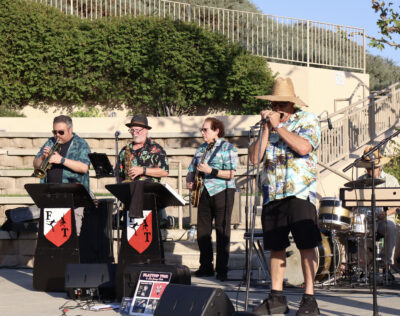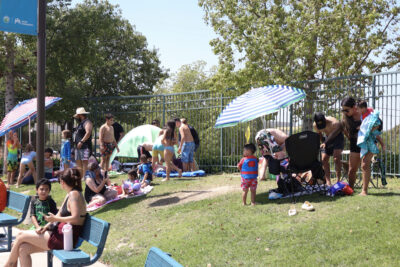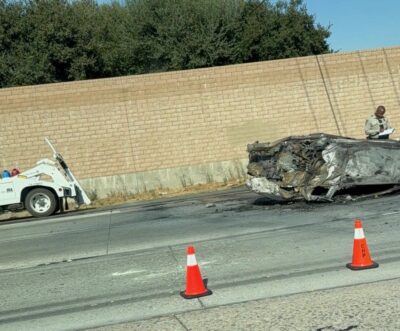Right before midnight on the night of March 12, 1928, the St. Francis Dam in San Francisquito Canyon collapsed destroying homes from the Santa Clarita Valley to the Pacific Ocean and claiming the lives of over 400 individuals.
In observance of the 96th anniversary of the man-made dam’s failure, the Santa Clarita Valley Historical Society led a group of individuals on an immersive tour to learn about the rich history of its infrastructure and view the last of its remnants on Saturday. The annual tour booked up quickly, so the SCV Historical Society has added another tour on April 27 starting at 10:30 a.m.
One hundred tour-goers were taken on a bus to the San Francisquito Canyon site where the St. Francis Dam once stood almost a century ago. Attendees were divided in two groups for the 1.5-mile hike that consisted of scenic views and rich history shared by archeologist Ann Stansell, and Frank Rock, also known as the “Dam Man.”
The second group was led by SCV Historical Society President Alan Pollack and Dianne Hellrigel.
Throughout the 1.5-mile moderate hike, Stansell and Rock alternated when sharing important facts about the dam and how a landslide led to its collapse.
Stansell became invested in the history of the St. Francis Dam when it became her focus of her thesis in 2014 before graduating from California State University, Northridge. In the process, she tried to determine the number of casualties and how they were commemorated after the disaster, she said. In her findings she found that those lost due to the disaster are now buried in 64 cemeteries throughout the United States.
“[I] went to all the cemeteries and documented the various forms of grave marker commemoration based on ethnicities, [and so on] and tracked all the burials,” she said. “It’s super unique because so many people in 1928 just right before the Depression … people were in search of work and you had men from all over the country that weren’t from here.”

Throughout the hike, tour-goers walked through an eroded roadway that was collapsing in some areas, displaying how much time has passed since.
Arriving at the first site of an eroded piece of concrete, Rock held out his bullhorn and told the hikers what exactly they were looking at. The large piece of concrete had a large crack down the middle and large bushes and trees surrounding it with limited access. The block of concrete is named Block 19.
“That split only happened recently in the last two years,” said Rock. “That was natural.”
Much of the remaining concrete that once made up the dam was now slowly eroding and, at a glance, a passer-by wouldn’t be aware that it was once a part of something that held a large body of water.
Arriving at the center of the dam site, both Stansell and Rock pointed to the side of a mountain where the landslide activated the failure.
“The landslide was noticed by a gentleman on a motorcycle that was driving up for his shift at Powerplant 1,” said Stansell to the group of tourgoers. “He essentially saw that the road had dropped … he kept driving and he heard the most terrible sound and he stopped and he smoked a cigarette because it made him so nervous … by the time he reached Powerplant 1 they [the workers at L.A. Department of Water and Power] had known that the dam had gone out and he was probably the last person to have to hear it.”

Rock grew up in the Santa Clarita Valley and learned about the St. Francis Dam and its history in elementary school. He paid no attention to it at the time and described it as something he “took for granted,” he said.
After his wife brought home a book on manmade disasters, he began to truly appreciate the historical significance the location had to the SCV.
He began giving tours and lectures surrounding the dam’s history in 1993 and has done it every year since, he said.
His goal is to further educate people about important history that is often overlooked, he said.
“It’s a big part of our local history,” he said. “To me, I wish they would teach about St. Francis in high school or the middle school level … I’m sad that it’s not … it should be, where people can get a better understanding of what’s going on.”
Although the buses were full for the immersive tour, Rock hopes in the future they fill up with younger individuals to continue passing on the knowledge and history behind the disaster.
Throughout the hike, Rock and Stansell shared information about William Muholland, the engineer who designed the St. Francis Dam. They also shared knowledge about the night of the disaster, why it no longer is considered a tourist location, and answered questions from attendees.
The SCV Historical Society’s second tour is scheduled April 27. For reservations and more information, visit www.eventbrite.com/e/2024-newly-added-st-francis-dam-disaster-lecture-and-bus-tour-tickets-850261925307?aff=oddtdtcreator.








